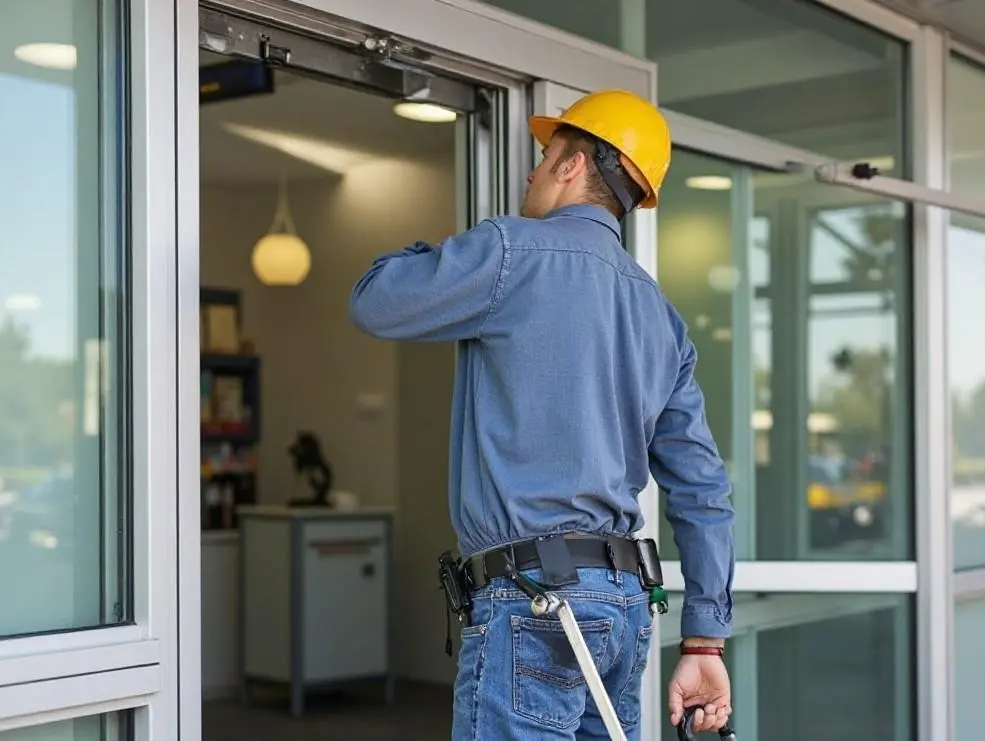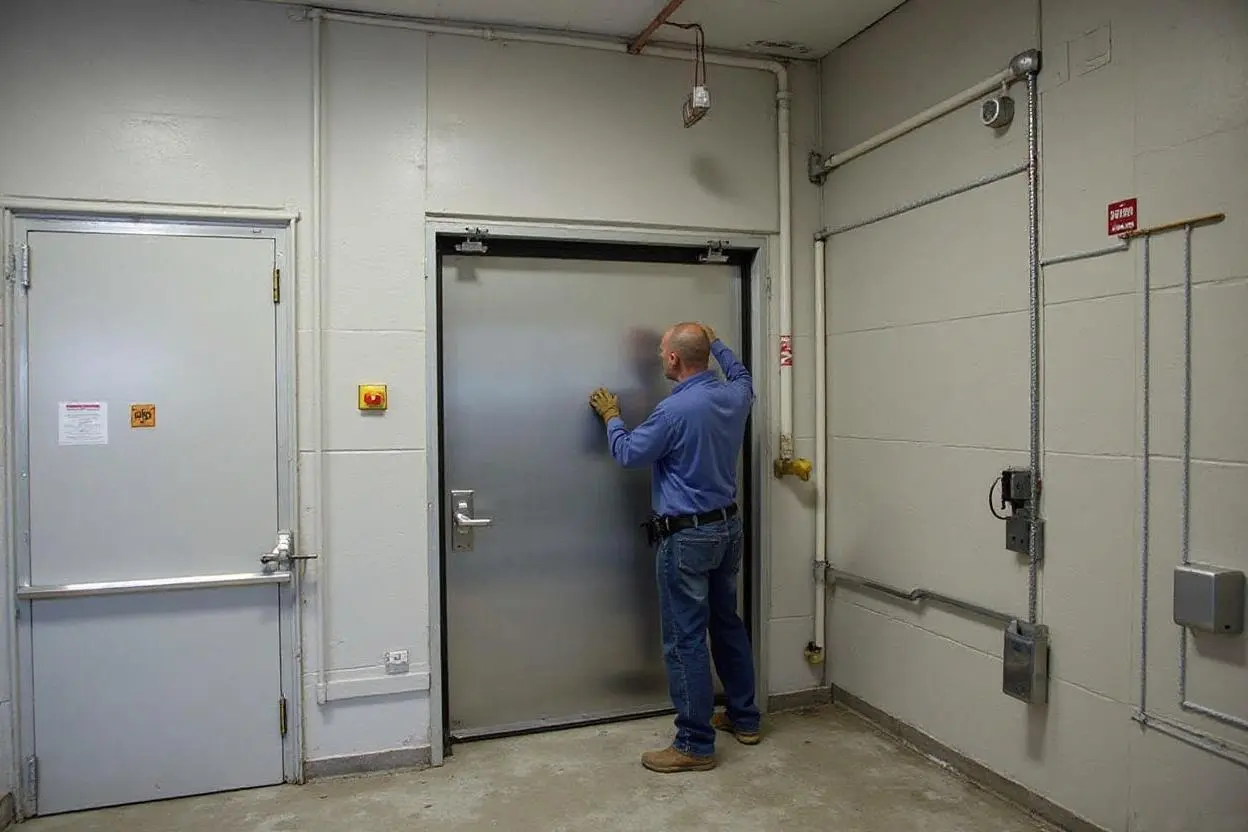How to Service an Automatic Door: Step-by-Step Tips for Safety and Performance
Automatic doors should feel invisible. They open, people move, operations flow. In Buffalo, NY, that quiet reliability gets tested by lake-effect snow, salt, and freeze-thaw cycles. A few deliberate maintenance steps keep doors safe, ADA-compliant, and on schedule through a full Erie County winter. This article explains how to service an automatic door the right way, what to watch for, and when to call a technician. It is written for building managers, facility teams, and owners who value uptime and safety.
Why routine automatic door maintenance matters in Buffalo
Cold snaps slow lubricants, salt attacks aluminum and steel, and slush blocks thresholds. Those local conditions add wear to sensors, pivots, rollers, and drive belts. A door that drags in January often becomes a service call in February. Regular checks reduce unexpected shutdowns, prevent injuries, and preserve the operator’s warranty. For retail, healthcare, and multifamily buildings in Buffalo and surrounding towns like Cheektowaga, Amherst, and Tonawanda, consistent maintenance also keeps traffic flowing during peak hours.
Safety first: power, signage, and control of the opening
Before any work, lock out the operator per manufacturer instructions. Post temporary signs to direct foot traffic. If the door serves egress, coordinate with building management and follow life-safety requirements so an alternate path remains open. No one should work under a live header or moving panel. For hospitals and pharmacies, plan off-hours checks to reduce disruption and contamination risk.
Step-by-step: servicing a sliding automatic door
Every brand has specifics, but the sequence below fits most commercial sliding systems.
-
Inspect the approach area. Clear mats, displays, and carts within the sensor zones on both sides. Obstructions cause false trips and slow cycles.
-
Clean the threshold and track. Remove grit, salt, and gum with a soft brush and vacuum. Wipe with a damp cloth. Do not flood the track. If ice forms at the sill in winter, treat it promptly and adjust snow-melt practices to keep water away from the opening.
-
Check rollers and guides. Look for flat spots, wobble, or metal shavings. Roll the panel by hand with power off. It should glide smoothly without binding. Replace rollers that chatter or leave dust on the track.
-
Verify belt condition and tension. A frayed or glazed belt slips under load. Press midway between pulleys; light finger pressure should deflect the belt slightly without sag. Adjust per spec. Over-tight belts wear bearings and motors.
-
Test presence sensors and safety beams. Clean lenses with lens-safe wipes. Walk-test approach sensors from various angles and speeds. Break the safety beam with a foot or object near the close path; the door should stop and reopen. If the door hesitates or misses, recalibrate or call a technician.
This short routine fixes many nuisance issues seen across Buffalo strip centers and medical offices, especially after storms and heavy foot traffic.
Servicing swing and folding operators
Swing doors face different stresses. Hinges and pivots carry heavy loads, and wind gusts on Elmwood Avenue or near the waterfront can push panels off speed. Check the arm connection points for looseness, examine hinge wear, and confirm the closer fluid is not leaking. Verify that the opening speed, backcheck, and latch speed meet ADA timing. For folding units, inspect panel-to-panel hinges and floor pins. Any audible grinding or banging during the cycle signals misalignment or a failing pivot.
Electrical checks that prevent downtime
With power locked out, remove the header cover. Look for loose terminal screws, browned connectors, and wire insulation rubbed by moving parts. Rodents and salt intrusion are common culprits in older storefronts near busy roads. Confirm the ground is secure. After re-energizing, review the operator’s fault codes, if available, and note any intermittent errors. A minor high-cycle fault caught early often beats a motor replacement later.
Sensor alignment and cleanliness
Most false openings come from dirty lenses or poor alignment. Ceiling-mounted or side-mounted microwave sensors should cover the approach, not the street. If a door in North Buffalo opens for passing buses, narrow the detection field and reduce sensitivity. For infrared presence sensors, maintain a clear, uniform floor surface. Highly reflective vinyl or bright wet salt patches can confuse sensors; a quick re-aim and sensitivity tweak usually fixes it.
Cold weather adjustments for Western New York
Operators slow in cold air. Doors facing Lake Erie winds need modest speed and force adjustments when temperatures drop. Maintain seals and brush sweeps to reduce drafts without dragging on the floor. Check heater kits in vestibules and keep the inner and outer doors balanced so one does not chase the other. Salt crystals at the sill act like sandpaper; increase cleaning frequency after each road salting.
ADA timing, force, and public safety
Compliance is not optional. Swing units should meet opening and closing timing and low opening force ranges published by the manufacturer and relevant code. For sliding systems, verify hold-open time allows safe passage for mobility devices and families with strollers. Place decals at eye level and at the push-plate height. Replace faded or missing decals immediately. A clear message reduces risky hand placement and avoids finger entrapment.
Maintenance intervals that work
In Buffalo’s climate, quarterly professional service suits most retail automatic doors and healthcare entrances. High-cycle doors at supermarkets or hospitals may need monthly checks during winter. Light-use office doors often run well on a twice-yearly plan, with a quick mid-season visit to clear salt and confirm sensor performance. Always schedule a professional inspection after impact from a cart, pallet jack, or vehicle.

What building staff can do between visits
A few minutes each week extends equipment life.
-
Keep the approach clear, floors dry, and mats flat and anchored. Bunched mats trigger sensors and trip pedestrians.
-
Wipe sensor lenses and push plates. Use non-abrasive cleaners and avoid overspray into headers.
-
Listen for changes. New noises signal wear. A soft hum is normal; a grind, slap, or squeal is not.
-
Watch closing edges. If panels touch before full closure or bounce off the jamb, call for adjustment.
-
Record issues with date and weather conditions. Patterns help diagnose thermal and salt-related problems.
Common Buffalo-specific issues and fixes
Salt corrosion: White powder on aluminum frames and pitting on steel push plates appear mid-winter. Neutralize with a mild cleaner, rinse, dry, and apply a corrosion inhibitor approved for door hardware. Consider protective kick plates where carts make contact.
Ice dams at sidewalks: Poor drainage sends meltwater back into the threshold. Regrade mats, clear drains, and add a small drip edge if needed. For recurring freeze at the sill, ask about heated thresholds or different mat strategy.
Wind tunnel vestibules: Opposing doors can fight each other. Adjust hold-open times so only one door is moving at a time, or add wind compensation settings available on many operators.
Power quality dips: Older commercial strips see voltage sag during storms. Surge protection and a line conditioner reduce nuisance resets and board failures.
When to call A-24 Hour Door National Inc
If the door does anything unexpected, stops mid-cycle, or shows an error code, stop use and call. Do the same after any impact, visible belt damage, or sensor failure. A-24 Hour Door National Inc services automatic doors across Buffalo, Amherst, Cheektowaga, Hamburg, and Niagara Falls. Technicians carry common rollers, belts, sensors, and control boards to shorten downtime. Same-day emergency response is available, including nights and weekends during snow events.

What a professional tune-up includes
A proper service visit goes beyond cleaning. The technician will verify approach and presence zones, recalibrate sensors, check operator torque, tighten hardware, inspect hinges and pivots, align panels, set ADA-compliant speeds and timings, review fault logs, and test safety systems with documented results. If the door is part of a fire-rated corridor or a hospital suite, the checklist includes code-specific steps and reporting for your records.
Budgeting for reliability
Most commercial automatic doors in Buffalo operate 60 to 200 cycles per hour in busy locations. Under those loads, rollers and belts typically last 12 to 24 months, sensors 3 to 7 years, and operators 8 to 12 years with regular care. Building a small quarterly budget for automatic door maintenance prevents large capital surprises. Track cycle counts if your operator supports it; replacing a $50 roller beats running a $2,000 operator hot until failure.
Ready for a safer, smoother entrance?
If the automatic door hesitates, opens for street traffic, or drags on cold mornings, it is time for a check. A-24 Hour Door National Inc offers preventive maintenance, tune-ups, and emergency repairs for sliding, swing, and folding automatic doors across Buffalo, NY and nearby neighborhoods. Call to schedule a visit, request a quote, or set up a quarterly plan that fits your building’s traffic and season. The right maintenance keeps people moving and problems quiet—through winter, spring thaw, and every busy day in between.
A-24 Hour Door National Inc provides commercial and residential door repair in Buffalo, NY. Our technicians service and replace a wide range of entry systems, including automatic business doors, hollow metal frames, storefront entrances, fire-rated steel and wood doors, and both sectional and rolling steel garage doors. We’re available 24/7, including holidays, to deliver emergency repairs and keep your property secure. Our service trucks arrive fully stocked with hardware, tools, and replacement parts to minimize downtime and restore safe, reliable access. Whether you need a new door installed or fast repair to get your business back up and running, our team is ready to help. A-24 Hour Door National Inc
344 Sycamore St Phone: (716) 894-2000 Website: https://a24hour.biz/buffalo
Instagram: @a24hourdoor
Buffalo,
NY
14204,
USA
Facebook: 24 Hour Door
Yelp: A-24 Hour Door National (Buffalo)
X (Twitter): @a24hrdoor